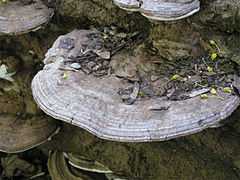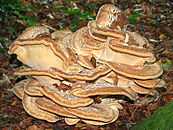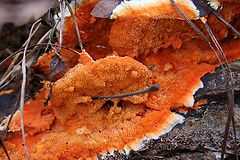Polyporales
| Polyporales | |
|---|---|
 | |
| Ganoderma applanatum | |
| Scientific classification | |
| Kingdom: | Fungi |
| Division: | Basidiomycota |
| Class: | Agaricomycetes |
| Order: | Polyporales Gäum. (1926) |
| Families | |
|
Cystostereaceae | |
| Synonyms | |
|
Aphyllophorales Rea | |
The Polyporales are an order of fungi in the division Basidiomycota, subclass Agaricomycetidae. The order includes some (but not all) polypores as well as many corticioid fungi and a few agarics (mainly in the genus Lentinus). Species within the order are saprotrophic, most of them wood-rotters. Those of economic importance include several important pathogens of forest and amenity trees and a few species that cause damage by rotting structural timber. Some of the Polyporales are commercially cultivated and marketed for use as food items or in traditional Chinese medicine.
Taxonomy
History
The order was originally proposed in 1926 by German mycologist Ernst Albert Gäumann to accommodate species within the phylum Basidiomycota producing basidiocarps (fruit bodies) showing a gymnocarpous mode of development (forming the spore-bearing surface externally). As such, the order included the ten families Brachybasidiaceae, Corticiaceae, Clavariaceae, Cyphellaceae, Dictyolaceae, Fistulinaceae, Polyporaceae, Radulaceae, Tulasnellaceae, and Vuilleminiaceae, representing a mix of poroid, corticioid, cyphelloid, and clavarioid fungi.[2]
The order was not widely adopted by Gäumann's contemporaries, most mycologists and reference works preferring to use the catch-all, artificial order Aphyllophorales for polypores and other "non-gilled fungi". When an attempt was made to introduce a more natural, morphology-based classification of the fungi in the 1980s and 1990s, the order was still overlooked. A standard 1995 reference work placed most polypores and corticioid fungi in the Ganodermatales, Poriales, and Stereales.[3]
Current status
Molecular research, based on cladistic analysis of DNA sequences, has resurrected and redefined the Polyporales (also known as the polyporoid clade).[4][5][6] Though the precise boundaries of the order and its constituent families are yet to be resolved, it retains the core group of polypores in the family Polyporaceae, with additional species in the Fomitopsidaceae and Meripilaceae. It also includes polypores in the Ganodermataceae which were previously assigned to their own separate order, the Ganodermatales, based on their distinctive basidiospore morphology. Corticioid fungi belonging to the Cystostereaceae, Meruliaceae, Phanerochaetaceae, and Xenasmataceae are also included, as are the cauliflower fungi in the Sparassidaceae.[7]
Habitat and distribution
The order is cosmopolitan and contains around 1800 species of fungi worldwide.[6] All species in the Polyporales are saprotrophs, most of them wood-rotters. They are therefore typically found on living or moribund trees or on dead attached or fallen wood.
Economic importance
Many wood decay fungi in the genera Fomes, Fomitopsis and Ganoderma are pathogenic, causing butt and root rot of living trees and consequent losses in forestry plantations. Several species, such as the mine fungus Antrodia vaillantii, can rot and damage structural timber.[8] Some of the Polyporales, notably Ganoderma lucidum (ling-zhi), Grifola frondosa (maitake),[9] and Trametes versicolor (yun-zhi),[10] are commercially cultivated and marketed for use in traditional Chinese medicine.
Genera Incertae sedis
There are several genera classified in the Polyporales that for various reason have not been assigned to a specific family. They are incertae sedis with respect to familial placement. Some may be poorly known and/or not included in DNA phylogenetic studies, or when they have been, did not clearly group with any named family (In some cases a new family must be created rather than the placement clarified.). These include:
- Crustodontia Hjortstam & Ryvarden (2005)[11]
- Crystallocystidium (Rick) Rick (1940)
- Globosomyces Jülich (1980)[12]
- Globuliciopsis Hjortstam & Ryvarden (2004)[13]
- Irpicochaete Rick (1940)
- Nigrohydnum Ryvarden (1987)[14]
- Obba Miett. & Rajchenb. (2012)
- Phlebiella P.Karst. (1890)
- Repetobasidiopsis Dhingra & Avn.P.Singh (2008)
- Sebipora Miett. (2012)
- Taiwanofungus Sheng H.Wu, Z.H.Yu, Y.C.Dai & C.H.Su (2004)[15]
-
-1.jpg)
Ganoderma lucidum (Ganodermataceae)
References
- ↑ Zhao C-L, Cui B-K, Song J, Dai Y-C. (August 2014). "Fragiliporiaceae, a new family of Polyporales (Basidiomycota)". Fungal Diversity. doi:10.1007/s13225-014-0299-0.
- ↑ Gäumann, E. (1926). Vergleichende Morphologie der Pilze. Jena: Gustav Fischer.
- ↑ Hawksworth DL, Kirk PM, Sutton BC, Pegler DN. (eds) (1995). Dictionary of the Fungi. 8th Ed. Wallingford, Oxford: CABI. ISBN 0-85198-885-7.
- ↑ Hibbett DS. (2006). "A phylogenetic overview of the Agaricomycotina". Mycologia 98: 917–925. doi:10.3852/mycologia.98.6.917. http://www1.univap.br/drauzio/index_arquivos/Myco09.pdf
- ↑ Binder M. et al. (2005). "The phylogenetic distribution of resupinate forms across the major clades of mushroom-forming fungi (Homobasidiomycetes)". Systematics and Biodiversity' 3: 113–157. doi:10.1017/s1477200005001623.
- ↑ 6.0 6.1 Sjökvist E, Larsson E, Larsson K-H. (2009). "A multi-locus phylogeny of the Polyporales (abstract)". Abstract Book, Botany & Mycology, Snowbird, Utah, July 25–29, 2009. http://swepub.kb.se/bib/swepub:oai:services.scigloo.org:112581?tab2=abs&language=en
- ↑ http://www.indexfungorum.org/Names/Names.asp
- ↑ http://www.buildingpreservation.com/Rots.htm
- ↑ http://www.adaptogeno.com/productos/maitake_ing.asp
- ↑ http://psp-research.com/psp9.htm
- ↑ Hjortstam K, Ryvarden L. (2005). "New taxa and new combinations in tropical corticioid fungi, (Basidiomycotina, Aphyllophorales)" 20. pp. 33–41.
- ↑ Jülich W. (1980). "Notulae et novitates Muluenses". Botanical Journal of the Linnean Society 81: 43–6. doi:10.1111/j.1095-8339.1980.tb00940.x.
- ↑ Hjortstam K, Ryvarden L. (2004). "Some new tropical genera and species of corticioid fungi (Basidiomycotina, Aphyllophorales)". Synopsis Fungorum 18: 20–32.
- ↑ Ryvarden L. (1987). "New and noteworthy polypores from tropical America". Mycotaxon 28 (2): 525–41 (see p. 532).
- ↑ Wu SH, Yu ZH, Dai YC, Chen CT, Su CH, Chen LC, Hsu WC, Hwang GY. (2004). "Taiwanofungus, a polypore new genus". Fungal Science (in Chinese) 19 (3–4): 109–16.
![]() Media related to Polyporales at Wikimedia Commons
Media related to Polyporales at Wikimedia Commons
![]() Data related to Polyporales at Wikispecies
Data related to Polyporales at Wikispecies





